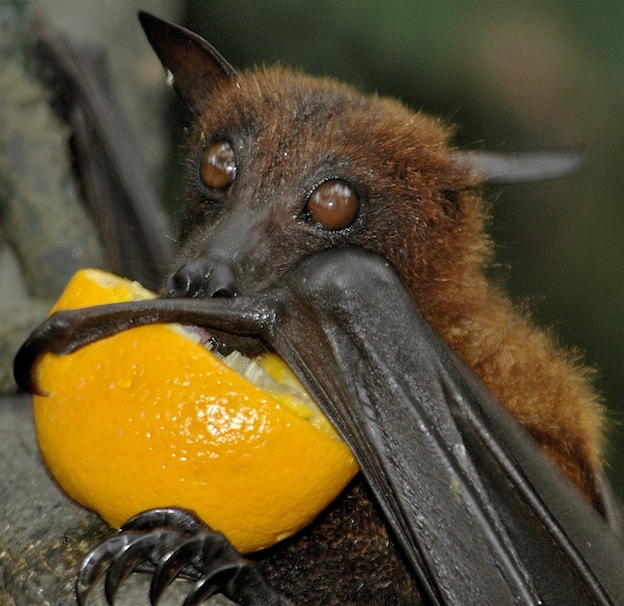Whereas most of the coevolutionary relationships discussed in this blog have revolved around specialized microbats and their plant food sources, megabat flying foxes also have some important associations with plants. Flying foxes are nearly always frugivorous or nectarivorous, feeding on tropical fruits and flowers from Africa, Australia, and Asia (Figure 1; Kunz and Fenton 2003). There has been much speculation as to the extent of pollination actually achieved by flying foxes, but seed dispersal has been studied as a major ecosystem service provided by these bats. Like their microbat counterparts, flying foxes can travel enormous distances each night for forage (up to 200 km in some cases), and thus play an important role in dispersing seeds from the fruit they eat and in forest regeneration (Kunz and Fenton 2003).
 |
| Fig 1. Flying fox eating an orange (species unknown). Accessed 23/5/2015; Available from http://www.batworlds.com/bat-feeding/. |
Nyhagen et al. (2005) found that Pteropus niger, an endemic species of flying fox on the island of Mauritius, has a profound role in forest regeneration of the island. They found that P. niger feeds on up to 22 different species of plants and disperses their seeds in their faeces, mature and undamaged. Many seeds were even found to be germinating within the bat droppings, possibly from an increased availability of fertilizing nutrients while passing through the bat's digestive system (Nyhagen et al. 2005). Because these bats feed on such a wide variety of fruits, they are important in maintaining genetic connectivity between forest fragments and can maintain plant diversity within these fragments (Nyhagen et al. 2005). In another study, Thomas (1982) found that up to 98% of the first woody plants to establish in forest fragments were from seeds dropped by flying foxes.
These results suggest that plants have established important adaptations to improve seedling survival and germination following vertebrate dispersal. In order to survive the acidity and danger of a bat's digestive tract, plants dispersed by bats typically have very hardened embryos and even favor nutrients within a bat's faeces (Kunz and Fenton 2003).
References
Kunz, T.H. & Fenton, M.B. 2003, Bat ecology, Paperback edn, University of Chicago Press, Chicago.
Nyhagen, D.F., Turnbull, S.D., Olesen, J.M. & Jones, C.G. 2005, "An investigation into the role of the Mauritian flying fox, Pteropus niger, in forest regeneration", Biological Conservation, vol. 122, no. 3, pp. 491-497.
Thomas, D.W. 1982, The ecology of an African savanna fruit bat community: resource partitioning and role in seed dispersal, .
No comments:
Post a Comment